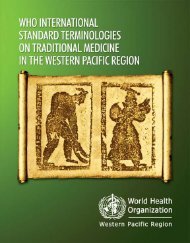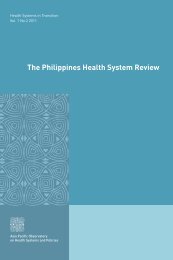Download pdf, 989kb - WHO Western Pacific Region - World Health ...
Download pdf, 989kb - WHO Western Pacific Region - World Health ...
Download pdf, 989kb - WHO Western Pacific Region - World Health ...
You also want an ePaper? Increase the reach of your titles
YUMPU automatically turns print PDFs into web optimized ePapers that Google loves.
A Review of Literature and Projects 2005<br />
II. Male students scored higher than<br />
female students, and medical students<br />
did better than non-medical students,<br />
scoring 60.6% on average. A baseline<br />
survey of 100 students aged 15-17 years<br />
in the State of Melaka found that friends<br />
were the main source of social support<br />
and information, followed by teachers,<br />
magazines (girls only) and the Internet.<br />
On the other hand, family problems were<br />
discussed within the family. When asked<br />
to name information sources for sexual<br />
and reproductive health topics, about<br />
one-third to two-fifths answered “do not<br />
understand the meaning” and a quarter<br />
said “nobody.” Newspapers and<br />
magazines were the primary sources for<br />
information about family planning,<br />
abortion and STI.<br />
The varying, but generally low levels of<br />
knowledge in some areas of sexual and<br />
reproductive health is a cause for<br />
concern. Other disturbing features are<br />
the fact that this appears not to have<br />
improved over time, and that whatever<br />
little and often inaccurate information<br />
they have comes from sources that are<br />
not very reliable (such as from one<br />
another). The fact that young people do<br />
not, as a preference, approach parents<br />
and teachers for information on sexual<br />
relationships needs to be studied<br />
carefully. The reasons could reside in any<br />
number of possible areas, such as<br />
cultural norms, failure of parents/<br />
teachers to communicate, or their own<br />
attitudes and lack of knowledge. This is<br />
relevant because interventions will need<br />
to be guided by the reasons. It is also<br />
significant that large number of<br />
adolescents (73%) expressed the need for<br />
more knowledge, indicating that they<br />
were aware of their own lack of<br />
information. This is a positive finding<br />
that needs to be used optimally in the<br />
formulation of polices, strategies and<br />
activities.<br />
3.2.2. Sexual development<br />
The review could find very little literature<br />
on sexual development. Information was<br />
only found on menarche for girls and wet<br />
dreams for boys. For menarche, the<br />
1994/1995 National Study on<br />
Reproductive <strong>Health</strong> and Sexuality<br />
showed that the overall mean age at<br />
menarche among the 706 female<br />
respondents (now aged 13-19 years) was<br />
12.6 years. The range was from younger<br />
than 10 years (2.7%) to 14 years (5.4%).<br />
The majority (68.2%) had their first<br />
menstruation at the age of 11 or 12.<br />
When asked about their feelings at first<br />
menstruation, slightly more than half<br />
(54.0%) indicated that they had expected<br />
the event. Of those who had expected<br />
it, 48.2% said they had ”felt afraid.” That<br />
percentage rose to 77.4% for those who<br />
had not expected the onset of<br />
menstruation.<br />
27

















